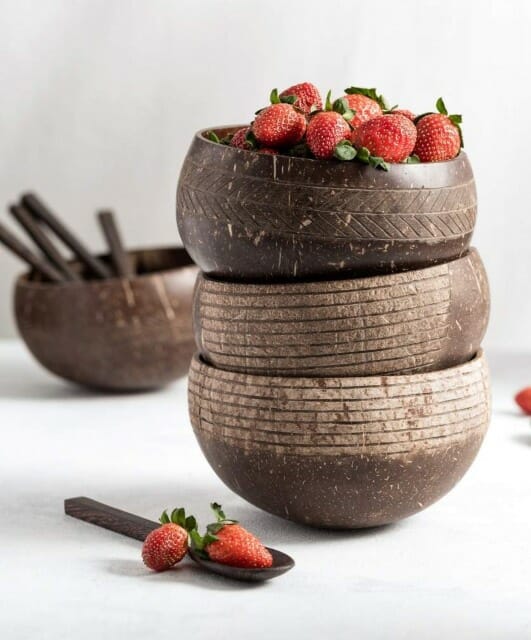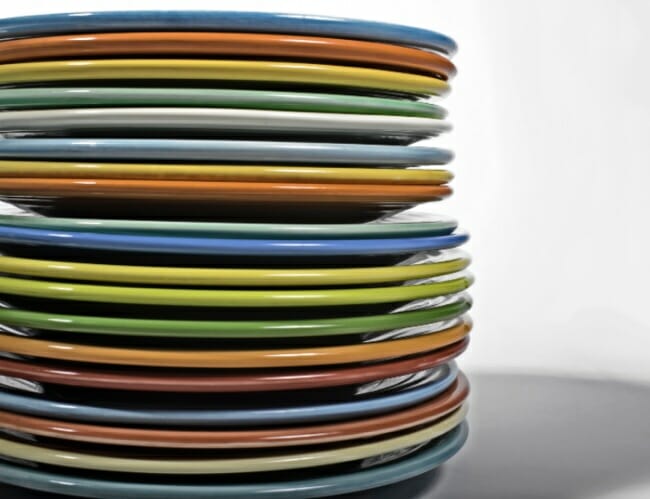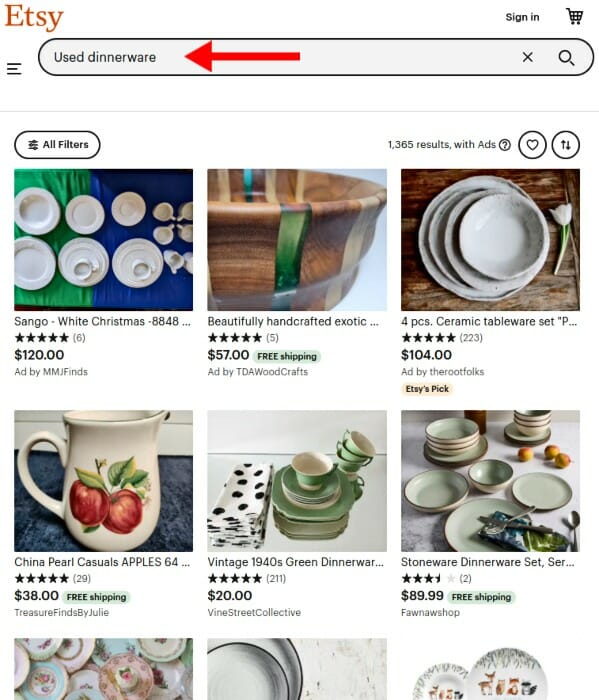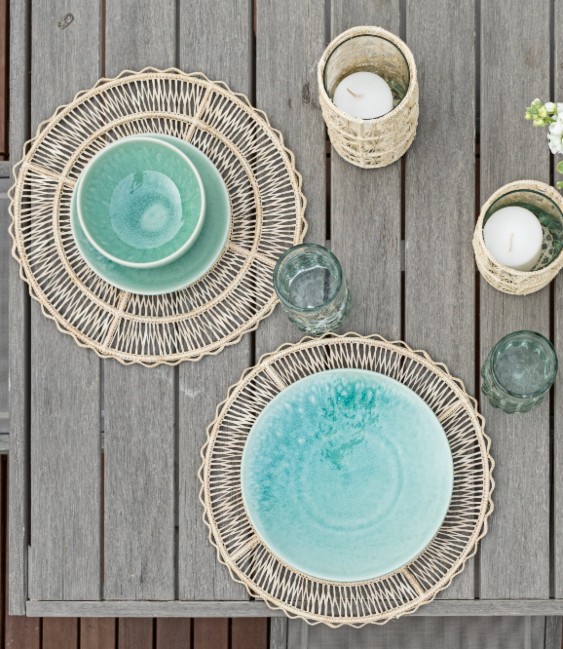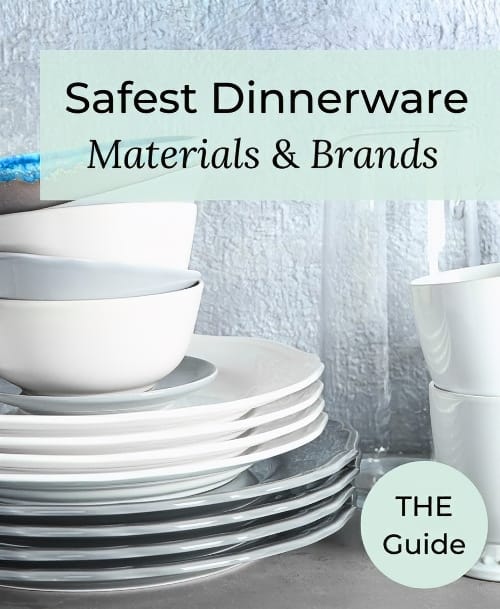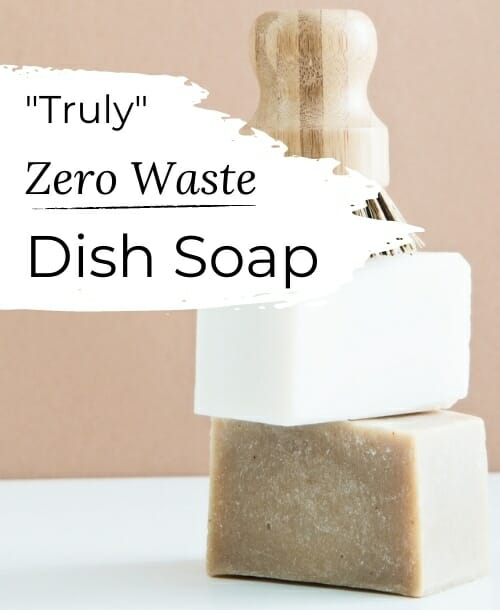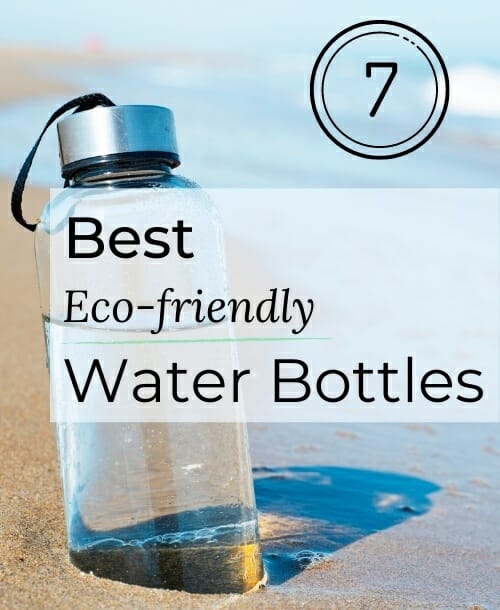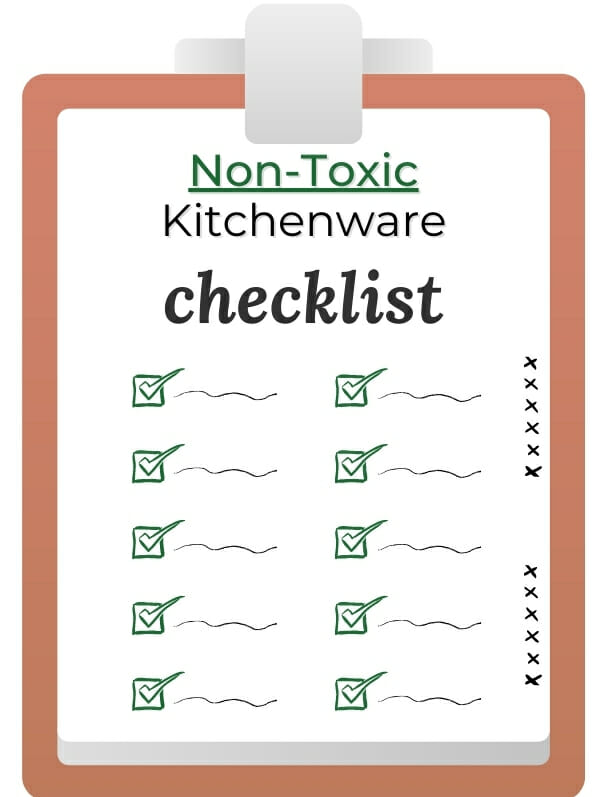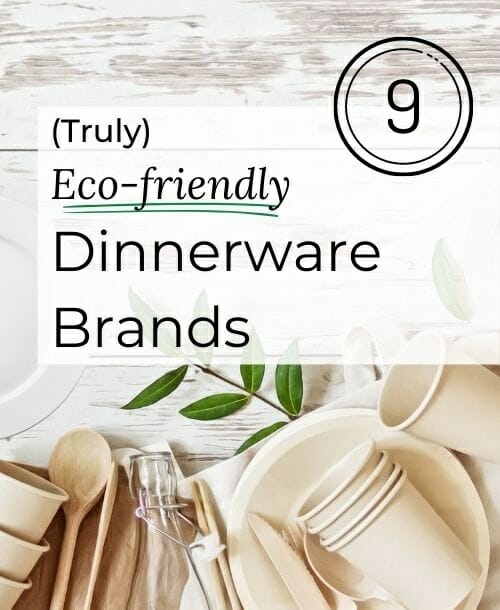
Is eco-friendly dinnerware really the foundation of greener dining? Well, we often think of food first when “greening up” the table – going vegan, for example.
While important, I’d argue that your dinnerware selection is just as vital. The wrong dishware leads to pollution, global warming, the consumption of toxins, and, believe it or not, reducing the planet’s oxygen levels. We’ll touch on that later.
But what exactly is sustainable dishware?
It involves much more than material. Where you buy your dinnerware, and from whom, is equally important. That’s where this guide comes in – we did the heavy lifting for ya!
Below, you’ll discover:
The seven criteria that make dinnerware “sustainable.” The three dinnerware materials you must either avoid or take caution with. The nine most eco-conscious dinnerware brands and marketplaces online – reviewed.
And, at the end, practical tips on identifying your own sustainable and non-toxic dinnerware… Whenever and wherever.
What Makes Sustainable Dinnerware… Sustainable
…& what to avoid moving forward:

Dinnerware that is “sustainable” should always follow the seven above criteria.
And the best place to score it?
Your local secondhand store. You can find tons of used ethical tableware there, waiting for a new life.
Side note: Whenever buying dinnerware (especially secondhand), you must consider various safety concerns—more on that in a second.
But, not every town has a thrift store. And some prefer to buy new. So, this guide focuses on the best new and used options online.
We used these criteria to assess the nine dinnerware picks below:
- Sustainably-sourced materials.
- Brand transparency.
- Ethical manufacturing.
- Durable, non-toxic, and eco-friendly reusable dinnerware materials that: (A) Don’t need frequent replacement, and (B) Won’t poison your food.
- Environmental initiatives like carbon-neutral shipping.
- Low impact product packaging.
- Charitable contributions to eco-friendly nonprofits.
And here’s what I meant by “consider various safety concerns” and why I underlined “non-toxic” just above…
You must avoid two types of dinnerware – and use caution with the third. Doing so ensures both an eco-friendly and non-toxic table.
Because avoiding toxins, in turn, protects wildlife and the environment, too.
1. Plastic – Why you must avoid it:

Plastic production and incineration will emit 850 million tons of greenhouse gases this year alone, according to wwf.org.
Hello, climate change.
Plus, most polluted plastic ends up in the ocean, taking 450-1000+ years to break down.
And this ocean plastic breeds trouble for wildlife.
This year alone, millions of marine animals will die from getting entangled, suffocated, and starved… This includes the most worrisome, Prochlorococcus.
These tiny ocean bacteria produce 10% of the world’s oxygen (one in ten breaths!), and plastic kills it.
You’re not untouched either.
Plastic chemicals, like BPA, can leach into your food when exposed to heat—microwaving leftovers, for example.
Once consumed, these chemicals disrupt your hormones. Medical News Today states how this causes infertility and other issues. Yuck!
And “BPA-free” plastics aren’t any safer; in fact, often, they’re worse.
2. Melamine (includes most bamboo) – Why you must avoid it:

Melamine dinnerware often comes in two forms: Melamine plastic and melamine bamboo dishes.
- Melamine plastic
Manufacturers use formaldehyde resin to produce melamine dinnerware. Formaldehyde, you know, embalming fluid…
This resin can leach into your food, most often at temperatures above 160°F – according to the FDA. An example of this is reheating food in the microwave for several minutes.
Studies on lab animals show melamine leads to kidney toxicity and appetite loss, to name a couple.
So, you cannot safely microwave melamine.
It also has the same environmental issue as plastic – polluting waterways for hundreds of years.
And studies show melamine impacts growth and hatch rates in several marine species.
Bad stuff.
- Melamine bamboo
Ironically, you’ll find the same problem in most bamboo dinnerware – despite people calling them “eco-friendly dishes.”
Manufacturers use melamine-formaldehyde resin to bind the bamboo fiber together.
Yet, there’s hope.
Melamine-free bamboo tableware exists, although scarce. You’ll discover an excellent option below.
Plus, at the end of this post, you’ll find actionable tips showing you how to check if bamboo contains melamine.
3. Ceramic dinnerware – Why you must use caution:

It’s crucial when buying ceramics—mainly secondhand—to ensure the piece is lead-free or lead-safe.
Here’s why:
Manufacturers sometimes use lead in ceramics to help fuse glaze onto the porous clay. This glaze allows the dish to hold food and liquids.
When manufactured correctly, there’s no lead to worry about. It’s bound in the plate’s glaze.
But, if incorrectly manufactured (baked at the wrong temperature/ for the wrong duration), lead does not fully fuse to the clay… This is how lead leaches.
So, how can you tell if a piece of ceramic dinnerware is safe?
There are several red flags to watch for, which you’ll find at the bottom of this article in the Buying Tips section.
Or, take advantage of my heavy lifting and explore the nine safest, most eco-conscious dinnerware brands below… All following the above criteria to a T.
The 9 Most Eco-friendly Dinnerware Brands and Marketplaces
…to buy quality, ethical dinnerware – new or used:
Below, you’ll find two groups: Numbers 1-6 are brands.
And numbers 7-9 are marketplaces. These marketplaces curate sustainable dishware from artisans across the globe.
All nine picks meet several, if not all seven of our eco criteria and come in the most sustainable materials… You’ll find vegan porcelain, recycled ceramic, melamine-free bamboo, and one disposable tableware brand using upcycled plant fiber!
Ready? Let’s explore!
(You can click the highlighted text below to jump ahead)
- Costa Nova (Recycled ceramic)
- Bibol (Melamine-free bamboo)
- Royal Doulton (Vegan porcelain)
- Jungle Culture (Coconut & bamboo)
- Fiestaware (Partially recycled ceramic)
- World Centric (Upcycled plant fiber)
- Etsy (Marketplace)
- Shades of Green (Marketplace)
- The Little Market (Marketplace)
Eco-Friendly Dinnerware Brands
#1
Costa Nova (Recycled ceramic)
Who are they?
Costa Nova is among the few ethical dinnerware brands producing ceramic this way:
They recycle their factory’s excess clay into brand new eco dishware—all under one roof—limiting transport emissions.
That’s right. Costa Nova, located in Portugal, takes a circular approach to production.
What they do:
Using this waste clay, Costa Nova makes Eco-Gres™ – their 90% recycled ceramic dinnerware.
By recycling clay, they reduce their ecological footprint, landfill waste, and capital and energy use. Plus, of course, conserve natural resources.
Furthermore, Costa Nova uses a 2160℉ single-firing system to bake their ceramic.
Single-firing uses 50-70% less energy than the standard double-firing system, reducing emissions.
As a result, this ceramic isn’t only eco-friendly, but the quality is impeccable, too.
Each piece sports a lead-free, shock and chip-resistant glaze, ensuring a long lifespan. Remember, that’s key for sustainable dishware.
Plus, this ceramic is versatile, being microwave, freezer, and oven-safe.
Choose from a modern yet straightforward color assortment – either pure white or white with sharp gray detailing. All coloring is 100% lead and cadmium-free, complying with California’s mega-strict Proposition 65.
All Products Available: Eco-friendly plates and bowls in all sizes. Costa Nova also carries baking trays, mugs, serving platters, and more.
Costa Nova’s other Eco-Friendly Practices & Ethics:
- Uses innovative, highly efficient equipment powered by their kilns’ waste heat.
- Uses solar power to reduce fossil fuel reliance.
- Reuses wastewater by working it into the production process.
- Commits to ethical business practices, a fair living wage, and high human rights standards for its employees.
- Uses 99% plastic-free packaging, intending to be 100% plastic-free soon.
Price Range: From around $40 per 4-pack up to $100, and everywhere between.
Available on Earth Hero – able to pay over two months in four tiny installments at 0% interest. 100% carbon-neutral shipping.
Looking to buy elsewhere? Explore all of Costa Nova’s available dishware here on Amazon.
#2
Bibol (Melamine-free bamboo)
Who are they?
Vietnam-based Bibol creates the only upcycled dinnerware made from 100% melamine-free bamboo trimmings!
Why bamboo? It’s easily the most sustainable material to use. Bamboo grows like a weed, and it’s lightweight, biodegradable, and tough as nails.
Hence why Bibol uses it.
Yet, it’s how they bind the bamboo together that sets Bibol apart from other brands…
What they do:
Bibol doesn’t use melamine with bamboo dust to mold their eco dinner plates.
Instead, their skilled workers gather local bamboo trimmings and peel off long, thin strips from each piece.
Then, gently by hand, they brush a natural cashew tree resin onto each strip as a binder.
Next, the artisans wrap the strands in a tight, circular pattern, one over the other—each strip widening the plate.
And finally, workers apply an all-natural lacquer (from marble powder) to coat and seal the bowl.
The result? Sustainable, beautiful, and all-natural dinnerware sets free from artificial chemicals.
All Products Available: Eco-friendly plates, bowls, serving trays, salad servers, and drinking tumblers in all sizes. Choose from nine different styles, including colorful, all-natural, lead-free pigments.
Bibol’s other Eco-Friendly Practices & Ethics:
- Fair Trade workplace that provides a livable wage and health care to workers.
- Never exposes workers to toxic chemicals or solvents.
- Uses local waste bamboo from native growing regions, meaning less travel and carbon emissions.
- Certified by the Ministry of Labor, Invalids, and Social Affairs of Vietnam for their contribution to the protection and care of children.
- Uses only biodegradable tableware materials, so no waste sits around in landfills.
- 100% carbon-neutral shipping and 1% of proceeds go to environmental nonprofits (when buying on Made Trade).
Price Range: Prices range from a low $16 up to $100, and everywhere between.
Available on Made Trade with the option to pay in four interest-free installments over two months.
Looking to buy elsewhere? This Vietnam-based Etsy seller provides the same type of melamine-free bamboo plates and bowls. Plus, they sell many other unique home decors.
#3
Royal Doulton (Vegan porcelain tableware)
Who are they?
Over 200 years ago, Royal Doulton began crafting fine porcelain in Burslem, England. Yet today, more than ever, they’re focused on mastering sustainability.
Using time-tested methods, this brand produces remarkably long-lasting and thus – sustainable dinnerware. At surprisingly low prices, too.
What they do:
They craft their porcelain using finer clay, packed at greater pressures, and baked much hotter than ceramic.
The result? A thinner, lighter-weight material – yet denser, less absorbent, and more chip/ shatter-resistant.
So, Royal Doulton’s collection will outlast most ceramics, preventing waste. Remember, a huge part of sustainability is the ability to sustain for a long time.
Plus, by weighing less, it’s easier to handle.
And don’t worry, Royal Doulton’s products pass the FDA’s, Proposition 65’s, and the CPSIA’s requirements for safety. No lead concerns here.
All Products Available: Complete dinnerware sets and individual dinner plates, bowls, drinkware, silverware, serveware, and more. All are available in nearly every size.
Royal Doulton’s other Eco-Friendly Practices & Ethics:
- Invests in making new products from 100% recycled materials.
- Runs a vintage service that buys and resells used dinnerware. They also recycle damaged items into construction materials.
- Has reduced landfill-bound waste by 79% since 2017.
- Uses 100% recyclable FSC-certified paper packaging and vegetable inks.
- Uses LED lighting and solar energy, cutting fossil fuel usage.
- Has cut supply chain greenhouse gas emissions by 44% since 2017.
- Supports employees with programs that enable them to earn more income.
- And this is just the tip of the iceberg. Fiskars Group (Royal Doulton’s parent company) has an 83-page sustainability report.
Price Range: Starts at the low price of $15 per set and $9 for single eco-friendly plates.
#4
Jungle Culture (Coconut & Bamboo)
Who are they?
Jungle Culture, an England/ Vietnam-based brand, has mastered turning trash into beautiful (and sustainable) dinnerware.
And does so in a way that benefits every party…
What they do:
Jungle Culture gathers leftover coconut shells from local farmers who earn a living extracting the milk and oil.
Typically, farmers burn away these shells and trees to create room for new crops.
But Jungle Culture’s Vietnamese artisans hand-carve those shells into fine eco-friendly bowls.
By doing so, JC helps farmers earn a secondary income while cutting waste and conserving resources.
And farmers aren’t the only beneficiary.
JC supports local artists in the region too. One by one, these skilled creators hand-etch unique, stunning designs into each bowl.
You can match your bowls with JC’s hand-carved, upcycled wooden cutlery sets. Workers source the material from a local furniture shop’s leftover ebony wood scraps.
For their bamboo cutlery, they source locally from Thanh Hoa Province, Northern Vietnam – a native bamboo hotbed.
And JC never uses melamine. Instead, workers hand-carve the utensils from a single piece of bamboo. So, each item is extra-durable, non-toxic, and unique.
All Products Available: Coconut bowls (available in five designs) and bamboo/ ebony wood flatware. Also, wooden cups, canvas totes, reusable straws, and more.
Jungle Culture’s other Eco-Friendly Practices & Ethics:
- A dedicated, Vietnam-based agent handpicks only the thickest coconut shells from each farm, so none break during transport. This process ensures no wasted shipping emissions.
- Uses the rivers, canals, and streams near the Ben Tre farms for organic irrigation to conserve water use.
- Their nomadic team constantly visits the Vietnamese farms and workshops to guarantee fair treatment of workers and 100% organic production.
- Uses plastic-free packaging to ship products.
- A 1% For the Planet member. 1% of your sale proceeds go to charities focused on restoring the environment.
Price Range: Prices range from roughly $9 – $30.
Available direct from Jungle Culture.
Looking to buy elsewhere? Explore Jungle Culture’s products right here on Amazon.
#5
Fiestaware (Partially recycled ceramic)
Who are they?
Fiestaware—a spinoff from the Homer Laughlin Company, circa 1871—is an iconic American brand laser-focused on three things:
Fun colors, durability, and sustainable production. And they’ve been this way for years…
What they do:
Since 1936, Fiestware’s master potters have called Newell, West Virginia, home.
By manufacturing right in the USA, Fiestaware is inherently good for the environment. It requires minimal transport, which produces minimal emissions.
Firing a blend of clay, feldspar, silica, and alumina, Fiestaware’s vitrified ceramic ranks as one of the strongest on the market.
Their dinnerware resists chipping and moisture like no other. Plus, it’s freezer, dishwasher, microwave, and oven-safe (up to 500℉).
You can rely on this long-lasting durability for years to come. And remember, durability is one of the critical components in eco-friendly design.
To further boost sustainability, Fiestaware blends its waste clay back into the formation process. So, each piece contains some recycled content.
All Products Available: Sustainable plates, bowls, cups, mugs, saucers, platters, and more. Mix and match with 18 vibrant, lead-free colors!
Since 1992, all colors and glazes have been 100% lead-free, acing independent lab tests. Fiestware’s leachable lead is 250x less than FDA limits.
Fiestware’s other Eco-Friendly Practices & Ethics:
- Reroutes kiln waste heat to power other processes. The waste heat from just one kiln replaces 1,000 homes’ worth of natural gas.
- Recycles 100 tons of steel, cardboard, and glass yearly.
- Cut their cardboard waste by a massive 340,000lbs – the equivalent to over 12 school buses.
- Their paperless ordering system conserves over a half-million sheets of paper yearly.
- A robust water treatment process helps Fiestaware reclaim 1.2 million pounds of otherwise waste glaze.
- Sends non-saleable (damaged) items to a refinery that recycles them into tabletops and countertops.
Price Range: Starts at $8 per plate and $32 per eco-friendly dinner set, increasing from there. Each product comes with a five-year chip protection warranty.
Looking to buy elsewhere? Explore tons of Fiestaware here on Etsy – just be careful to avoid those from pre-1992 (due to lead concerns).
#6
World Centric (Plant fiber, paper, & bioplastic)
Who are they?
Love it or hate it, certain occasions call for disposable tableware. Huge outdoor parties, for example.
Yet, we don’t want single-use plastic. That’s where World Centric comes in…
Since 2005, they’ve led the way with high-quality eco-friendly disposable dinnerware.
But, more than most brands, WC maintains an immense focus on eco-friendly ethics.
And it all starts with how they design their products:
What they do:
World Centric uses upcycled byproducts from other industries.
For example, their plant fiber tableware consists of bamboo, leftover sugarcane from sugar refinement, and waste wheat straw often burned away as a farming byproduct.
Compostable and renewable? Sure is! But those aren’t the sole benefits:
Upcycling this plant fiber protects forests, uses less energy, emits less pollution, and requires fewer chemicals to produce than paper products.
Plus, it provides extra helpful income to farmers.
You’ll also find this dinnerware is more sturdy and soak-proof than paper, despite no plastic or wax linings.
So, you can help the planet and leave your guests with a good impression!
And once finished with your camping trip, wedding, or other events, your tableware becomes valuable compost after 180 days!
All Products Available: All-natural plates and bowls (plant fiber), in multiple sizes and quantities. FSC-certified paper napkins, hot cups, and straws. And bioplastic utensils made from corn starch, tapioca roots, and sugarcane.
World Centric’s other Eco-Friendly Practices & Ethics:
- A certified B-Corp for social and environmental performance, accountability, and transparency.
- Frequently performs third-party factory audits to ensure fair working conditions, ethical worker treatment, and fair wages.
- 100% carbon-neutral operations.
- Uses renewable solar energy at their headquarters.
- Supports their staff financially in purchasing electric vehicles and using public transportation to reduce emissions.
- Instead of 1%, WC donates 25% OF PROFITS to environmental programs, totaling $1,565,954 in 2020 alone!
- You can view more of World Centric’s massive efforts here.
Price Range: Ranges from $4 for utensil 50-packs up to $100+ for massive dinnerware sets – and everywhere between.
Available on Earth Hero – able to pay over two months in four tiny installments at 0% interest. 100% carbon-neutral shipping.
Looking to buy elsewhere? Shop World Centric on Amazon.
Sustainable Dinnerware Marketplaces
#7
What is it?
Remember how I said thrift stores were the best place to buy, but how you might not have one in your area?
Now imagine if you could bring a massive thrift store, jam-packed with used dinnerware, right to your fingertips…
Well, you can. Welcome to Etsy!
How it works:
You can find nearly any type of dinnerware on there, both new and secondhand, in about any style and age:
Everything from a family’s old daily dish set or mismatched vintage china – to a collector’s decorative pieces from 1941.
That leads to the best thing about Etsy—
Its sellers, most of whom are modest and ethical collectors eager to share their passion.
Etsy bridges the gap between their passion for collecting and your desire for sustainable dishware.
For example, you’ll find several dedicated secondhand shops on Etsy, like Colorado Collection US or Parkwood Treasures, run by passionate collectors.
These folks attend frequent estate sales to gather used tableware, excited to share their findings with you.
*Important* When buying used, antique dinnerware on Etsy, you must keep the final Buying Tips section below in mind.
All Products Available: Sustainable plates and cutlery, bowls, and all other types of eco-friendly tableware in nearly every material, waiting for a new life.
Etsy’s other Eco-Friendly Practices & Ethics:
- Unique, ethical, and often handmade products from passionate sellers around the country.
- Sponsors projects that protect forests, build solar farms, and develop greener methods for auto production.
- Offsets 100% of their carbon emissions from operations. In the first year alone, they cut 381,399,714lbs of C02 pollution.
Price Range: Prices vary due to so many products. You can find items from a couple of bucks to hundreds.
#8
What is it?
With all the gimmicks and greenwashing, deep research is vital to finding brands that are truly sustainable. Wouldn’t it be awesome if there was a simple “eco-friendliness score” for each product you looked at?
Shades of Green (whose name will make more sense in a second) did just that:
How it works:
This ethical shopping platform created a rating scale system called, Shades of Green Product Evaluation Program.
Using this scale, they assess the brand’s sustainability in five key areas: 1. Sourcing, 2. Manufacturing, 3. Shipping, 4. Use & Performance, and 5. Lifecycle.
Then, they assign the product a rating, or Shade, of 1-5, each marked with a shade of green… Hence the company’s name.
Shade #1 is the lightest; #5 is the darkest. The darker the shade, the more eco-friendly the item or brand.
Once you click on a product, you’ll see the score up top near the price.
You can then click the “Detailed View” button to open a transparent breakdown of the score.
Honestly, it’d take hours to find this depth of information. But Shades of Green provides a shortcut; you can verify the sustainability of products in seconds!
All Products Available: Stoneware fair trade dishes and bowls (made in France) in several sizes and styles. Upcycled wood and palm fiber serving bowls (made in USA). Also drinking glasses, non-toxic cookware, and much more!
Shades of Green’s other Eco-Friendly Practices & Ethics:
- Supports artisans from around the world, often in places with little opportunity.
- A robust set of core values focused on product/ brand transparency from their vendors.
- Engages in sustainable community building, planetary stewardship, and supporting conscious consumerism.
- Invests heavily in educating shoppers on eco-friendly best practices through their blog.
- Runs a unique design service that provides eco-friendly home remodeling consultation.
Price Range: From $12 up to $240 and everywhere between.
#9
What is it?
Like #8 above, The Little Market has their own unique system of curating ethical products—
They enable you to shop by the specific causes you wish to support with your sale!
How it works:
This 501(c)(3) nonprofit shop sources eco-conscious, artisan-made goods from underserved communities.
The artisans TLM supports consist of 70 communities, including refugees, people with disabilities, survivors of sex trafficking, and individuals living in extreme poverty.
The goal? Support these creators by providing safe jobs and fair wages to end poverty.
By ethically sourcing products from these groups, TLM already benefits them financially. But then, they go a step further…
The Little Market gives back to these groups using their own sales proceeds!
Here’s an example… Let’s say you want to support refugee artisans:
Simply click “Shop by Cause” up top, then click “refugees + idps” in the dropdown. You’ll find products crafted by those individuals.
With your purchase, you support TLM’s charitable programs, which help these refugees rebuild their lives. Programs like community development, finance training, and health programs.
That’s just one example of the 14 causes you can support.
All Products Available: Handmade sustainable plates, bowls, drinking glasses, and much more – available in various sizes and designs. For materials, choose from ceramic, glass, or sustainably harvested acacia wood.
The Little Market’s other Eco-Friendly Practices & Ethics:
- Prioritizes products made from sustainable materials and recycles all waste from their operations.
- Members of the Fair Trade Federation and the Alliance for Artisan Enterprise.
- Has provided over 1,000,000 hours (114 years worth) of work to underserved communities since 2013.
- Allows disadvantaged artisans to name their price and pays them right away.
- Promotes and protects the traditional skills of small producers. This helps increase the demand for ethically-made products.
- Ensures artisans work in a safe environment – free from harassment, discrimination, and child labor.
Price Range: From $10 up to $76 and everywhere between.
3 Buying Tips to Find (Safe) Eco-friendly Plates and other Sustainable Dishware

Here are some practical tips to help you evaluate dinnerware’s safety… And avoid the unethical, unsafe stuff.
In fact, they’re some of the same methods I used for this post.
I want to leave you with these tips, so you can always make the right purchase moving forward.
First, a list of brand ethics to check for. Second, how to tell if bamboo contains melamine. And third, how to avoid risky ceramics.
1. Ethics to check for (ensure at least 2-3 of the following)
- Uses sustainably sourced materials (i.e., responsibly harvested bamboo, recycled glass or clay, locally sourced materials, etc.).
- Brand transparency (i.e., how the brand presents itself to be honest in public interactions, values, culture, business processes, product materials, etc.).
- Ethical manufacturing (i.e., the overall production of the product in regards to proper safety testing, documentation, labeling, a Fair Trade workforce, and minimizing waste).
- Practices environmental initiatives like carbon offset programs.
- Use low-impact product packaging.
- Donates to environmental nonprofits.
- (Most important!) Uses durable, eco-friendly, and non-toxic dinnerware materials that don’t need frequent replacement (reusables). Or, biodegradable/ compostable disposables.
Next, let’s further expand on safe materials…
As mentioned earlier, you’ll want to stay away from plastic and melamine entirely (including melamine bamboo) – for environmental and health reasons.
But, as I also said, melamine-free bamboo does exist. Bibol is one, but there are more.
Here’s how to find it:
2. How to check if bamboo dinnerware contains melamine

1. Examine the product’s material list (it should be in the product description).
Often, you’ll see the phrases “BPA-free” or “Phthalate-free.” Those are good things but irrelevant to what we’re hunting for.
2. Check for phrases containing “melamine.”
Common phrases used with bamboo dinnerware include “food-grade melamine binder” or “food-safe melamine.”
See the above screenshot.
Any time you see those terms (unless the page says “melamine-free”) abandon that product.
Side note: Melamine bamboo dishes tend to have bright colors and carry the label “dishwasher-safe.”
— Here’s a shortcut to find that information faster on any website:

Press the CTRL+F keyboard shortcut (Command+F on Mac) while on the product page on your desktop/ laptop.
If you’re unfamiliar, all you do is press the “ctrl” key and the “f” key simultaneously. Same for mac, but with the “Command” key.
Once you do, a little search bar will open up.
Type “melamine” into the search bar, and automatically, any mention of it will be highlighted. Go ahead, try it real quick on this page!
— Browsing on Amazon? Here’s another ninja tip:

I call this the “The Amazon Q&A Search Box Method.”
This tip is powerful because companies don’t always state if a product contains melamine.
But, a customer might’ve asked the seller if there’s melamine… This tip will show you the company’s answer. Here’s how to do it:
Once on the product page, scroll down to just above the reviews section.
You’ll notice the big, bolded words, “Customer questions & answers,” with a search bar underneath.
Type ”melamine” into that search bar.
Bang, within a second, any mention of melamine—not only in the product description—but in a customer’s review, question, or the company’s answer to that question, will populate right under the search bar.
Still no clear answer?
Search the brand name in Google and see if they have a website. Check their website’s FAQ (use the ctrl+f shortcut on the page).
3. How to avoid buying risky ceramic dinnerware
Sure, FDA regulations and mandatory testing help ensure dinnerware is safe. But, outliers can slip through the cracks.
By outliers, I mean ceramics made in China at unregulated, non-FDA-certified factories.
That’s why you should never buy ceramics from unknown, shoddy brands with no safety information.
If the brand does not perform its own third-party testing, there’s no way to tell if the dishware is safe.
So, always buy from reputable brands.
Check for test reports on the company’s FAQ or product pages proving it meets FDA or Proposition 65 standards.
To do this quickly, use your trusty CTRL+F shortcut: Type in phrases like Test, certified, third-party, lab, FDA, lead, cadmium, etc.
— Physical/ visual red flags for unsafe ceramic dinnerware:
(This applies when buying new, used, or accepting family hand-me-downs)
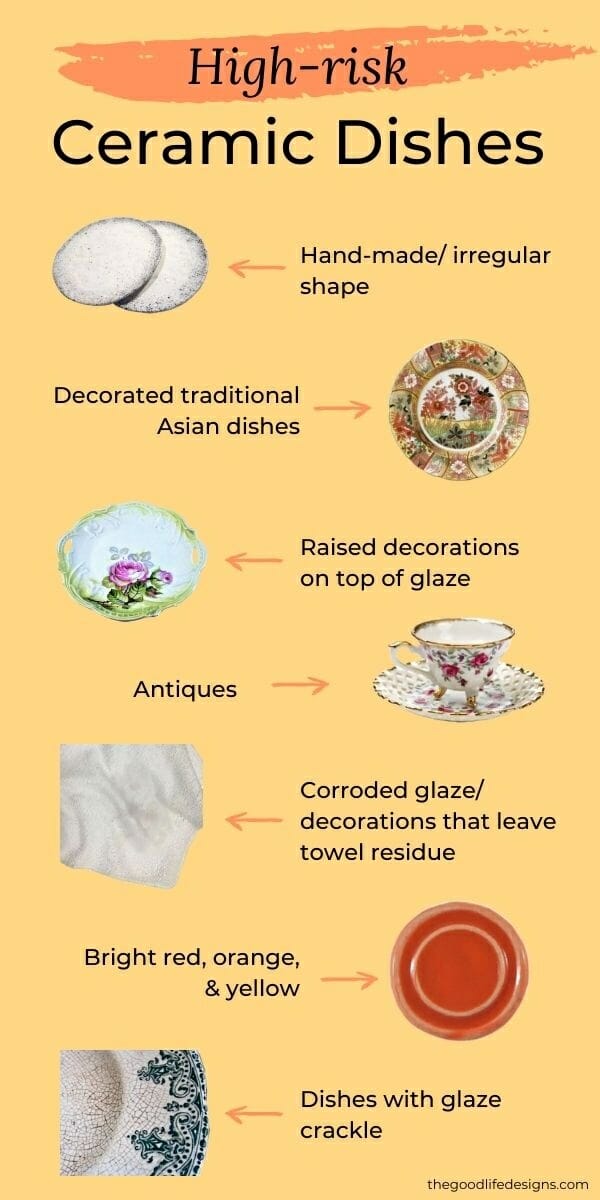
- Hand-made tableware with an irregular shape.
- Decorated traditional dishes used in some Asian communities, especially when made before the 70s. The FDA didn’t start regulating lead until then.
- Raised decorations above the glaze (you can feel the decoration when rubbing your finger over the dish).
- Antique tableware from relatives, thrift shops, flea markets, or garage sales… Especially if you can’t identify the manufacturer.
- Dishware with corroded, worn-out, or chipped glazing and/ or decorations (or if the dish leaves a gray residue on your towel after washing and drying).
- Bright red, orange, & yellow color patterns more often contain lead – it’s used to create deep, rich colors. (Unless you’re sure the manufacturer uses lead-free glaze).
- Dishes with glaze crazing or “glaze crackle” (when your plate is full of cracks).
Conclusion
There’s no shortage of plates, bowls, cups, etc., on the market – but not all are created equal.
Above, you found the nine most sustainable dinnerware brands and marketplaces. Each is a safe pick you can feel good choosing. You also discovered practical tips for evaluating dinnerware’s safety.
Knowing which materials to avoid and the specific criteria for eco-friendly dinnerware will make future buying decisions easier.
Now it’s time to choose a brand that reflects your values and style preferences—
Who will you pick?!
P.S. Your dish soap choice is equally essential to dinnerware – so check out our zero-waste dish soap guide!

Hi there! I'm Adam, author and founder of TGL. Since 2016, I've produced and sold non-toxic kitchenware throughout the US. Today, I'm using my passion and experience in sustainable product manufacturing to help families avoid unsafe reusable foodware. When I'm not writing, you'll find me hiking or camping throughout Appalachia!
Enjoyed this post? Share it with your friends!
Related Posts
FREE Guide
Non-Toxic Kitchenware Checklist
Get a step-by-step product guide with insider tips & tricks for the safest kitchen possible!




